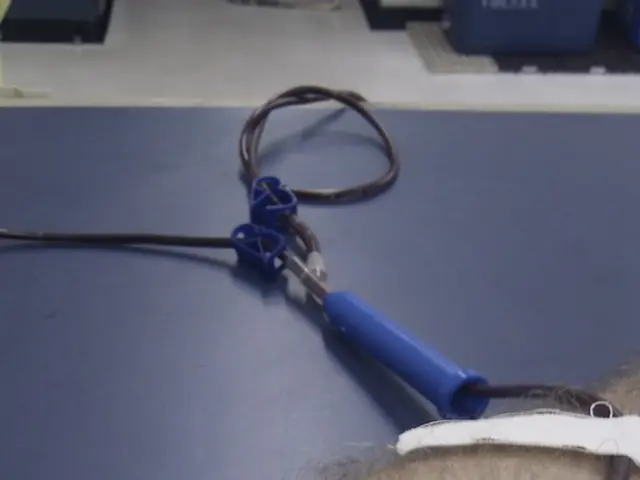Recovery Timeframe for Hip Replacements: Understanding the Process
Hip replacement recovery timelines can fluctuate from person to person, but most folk can kickstart light activities within 3 to 6 weeks post-surgery. However, your pre-surgery prep can significantly impact your recovery duration.
Weeks prior to the surgery, step up to prep your body for a partial or total hip replacement. Focus on that risk of complications and speed up recovery. Surgery prep remains the same for both types of surgeries, with similar outcomes for each.
Before the big day, here are some tips to get you ready:
- Discuss the procedure with your doc and research what to expect during and after the process.
- Strengthen your legs, core, and upper body with exercises suggested by your doctor.
- Maintain a moderate weight to lower the risk of complications during surgery.
- Consider quitting smoking or at least limiting it.
- Line up assistance for daily tasks during your week or two of recuperation at home.
- Prep meals in advance for easy eats post-surgery.
- Make your home more accessible and convenient for your return by stocking up on items like:
- a raised toilet seat
- safety bars in the bathroom
- a walker or crutches
Immediately following the surgery, you may stay in the hospital for 1 to 2 days, or even go home on the same day. Your doc will likely administer pain relievers such as opioids, local anesthetic, NSAIDs, or acetaminophen. Your incision will be stitched or stapled for about 2 weeks, requiring wound care at home as discussed with your medical team.
Your medical professionals will encourage you to get up and move around as soon as possible following the surgery, with walking short distances with assistance possible on the same day. A physiotherapist will show you exercises to strengthen your hip and advise on activities to avoid, as well as suggesting safe methods to sit and bend without damaging your new hip.
Once you're home, you may need assistance with daily tasks for several weeks, or possibly a stint in a rehabilitation facility. Pain and discomfort can last for a few weeks, with prescription medications required to help manage the pain. Physical therapy or recommended exercises at home may also be part of your recovery routine.
Around the 10-14 day mark, your stitches should be gone, and pain and swelling may start to subside, though not for everyone. Those who needed a cane or walker before the surgery may still need it during this early recovery period.
By the 3-6 week mark, most people can generally handle light activities of daily living and may even start to feel stronger, more stable, and more comfortable putting weight on their leg. Some may even be able to return to work after 6 weeks, but this varies. After 6-8 weeks, sexual activity may be safely resumed.
Physical therapy will continue to be essential for at least two months after surgery, and your doctor can discuss when it's safe for you to engage in additional exercise like swimming or walking. After 3 months, you may be able to resume daily activities, but always check with your doctor for evaluations and advice on the most beneficial physical therapy for your situation.
To improve your hip replacement recovery, here are some tips to follow:
| To do: | To avoid: || --- | --- || • Follow physical therapy exercises as directed | • Sitting still for long periods || • Try gentle exercises, such as daily walking | • Crossing the legs at the knee || • Sit in a reclining position | • Bending the hip more than 90 degrees || • Use a cold compress to reduce swelling | • Bending down to touch the feet or ankles || • Take prescription medications as instructed | • Sitting in low chairs || • Use walking aids if necessary | • Intense exercise, which may involve jumping or sudden turns || • Move or lift heavy objects |
Recovery in older and younger people can differ, with traditional recommendations advising against hip replacements for those under 20 due to unfavorable outcomes for certain conditions. However, modern hip replacement implants may lead to improved outcomes and survival rates in younger populations.
In older adults, recovery may be more challenging as they may have compromised mobility or pre-existing conditions such as heart and lung disease, clogged arteries, or high blood pressure. To reduce the risk of complications in older adults, it is crucial to seek diagnostic tests and treatments for these conditions.
For older adults, avoid falls if possible, and utilize a walker, crutches, or a cane until stability is achieved.
Hip resurfacing involves trimming and capping the femoral head with a metal cover instead of removing it, while still removing damaged cartilage and bone inside the socket and replacing it with a metal shell. Most people can go home between 1 to 4 days after hip resurfacing surgery and may begin putting weight on their leg immediately, but may require a walking aid for the first few days or weeks for support. Recovery can take several weeks with some discomfort, and physical therapy will be recommended to maintain range of motion and restore strength.
• follow physical therapy exercises as a physical therapist instructs• try other gentle exercises, such as daily walking• sit in a reclining position• use a cold compress to reduce swelling• take any prescription medications as a doctor instructs• use walking aids, such as crutches, if necessary
Hip replacements can lead to less pain, better mobility, a better quality of life, and improvements in daily activities. However, you may continue to experience some numbness, pain, or stiffness around the incision site, or restrictions due to the metal implant affecting metal detectors, high-impact sports, dental procedures, or sexual activity.
Enrichment Data:
Most people can return to work after hip replacement surgery within a timeframe that varies depending on their job type and individual recovery:
• sitting still for long periods• crossing the legs at the knee• bending the hip more than 90 degrees• bending down to touch the feet or ankles• sitting in low chairs• intense exercise, which may involve jumping or sudden turns• moving or lifting heavy objects
- Sedentary or seated work: Many patients can return within 1–4 weeks, with some sources indicating seated duties may be resumed in as little as 1–2 weeks as tolerated[1][4]. Others suggest that most patients return to sedentary work in about 3–4 weeks, depending on comfort and healing[4].
- Light physical work: Typically requires 6–8 weeks before a safe return[4].
- Heavy physical or manual labor: Usually requires 10–12 weeks, or sometimes longer, especially if the job involves demanding physical activity[3][4].
It is important to consult with your surgeon or healthcare provider, as recovery can vary between individuals and depend on specific job requirements[1][4]. Most patients can expect to resume normal activities with improved mobility and reduced pain between 3–6 weeks after surgery[2][4]. However, full recovery and return to all activities may take up to a year[5].
- Engaging in mental health therapies and treatments can be beneficial in managing stress and anxiety during hip replacement recovery.
- A healthy diet, focused on health-and-wellness and rich in fruits, vegetables, lean proteins, and whole grains, can aid in quicker recovery and better overall health.
- Regular scheduled fitness-and-exercise, such as stretching and low-impact aerobics, can improve cardiovascular health and speed up recovery.
- Timely screening and addressing medical-conditions like diabetes, chronic-diseases such as COPD, and pre-existing conditions like Alzheimer's can reduce the risks of complications during surgery.
- Medical-professionals may recommend weight loss for those with obesity to decrease the likelihood of complications during hip replacement surgery.
- AQ (Air Quality) should also be considered to promote a proper healing environment during recovery, as poor air quality may negatively impact overall health and recovery.
- Older adults may require additional time for recovery due to aging-related factors or pre-existing conditions, making it essential to prioritize preventive measures for falling and maintaining heart and cardiovascular health.
- Ulcerative colitis and other inflammatory bowel diseases might require special consideration before undergoing hip replacement surgery due to increased risks of complications.
- Hip resurfacing may offer advantages for individuals with certain chronic-diseases like arthritis, as it can preserve more of the natural hip joint, potentially leading to improved recovery and longer implant lifespan.








